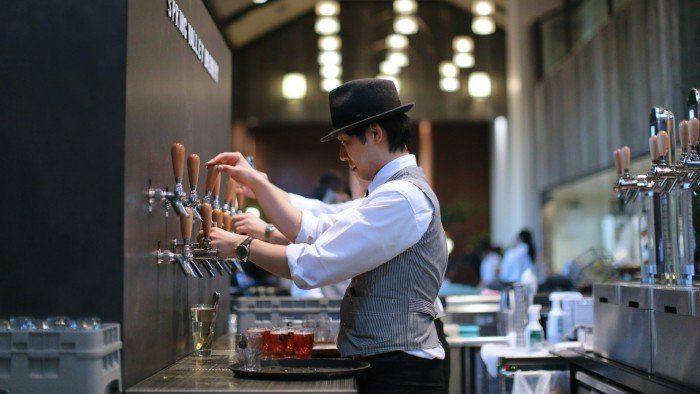This article is an on-site version of our Moral Money newsletter. Premium subscribers can sign up here to get the newsletter delivered three times a week. Standard subscribers can upgrade to Premium here, or explore all FT newsletters.
Visit our Moral Money hub for all the latest ESG news, opinion and analysis from around the FT
People taking better care of their health sounds like good news for humanity. Is it good news for your investments? Not if you’ve got a big position in the alcoholic drinks sector.
CONSUMER TRENDS
The alcohol industry’s looming hangover
Of all the words to have associated with your consumer products portfolio, perhaps the very worst is “carcinogenic”. So it was a bad day for the alcohol industry when, in January, the US surgeon-general recommended that bottles should carry warnings of cancer risk. Booze company stocks duly fell — but this was just one more indication of the growing financial risks for this sector, as health concerns weigh on sales.
This week we got some fresh signals of how companies are responding to signs of weakening alcohol demand that are particularly stark among the young.
In Japan — where per capita alcohol consumption has fallen more than a quarter since 1995 — the chief executive of brewer Asahi played down the idea that health worries were responsible. A bigger factor was the rise of digital entertainment platforms, Atsushi Katsuki said, adding that Asahi was now looking to boost drink sales to people who stay at home and game rather than going out to socialise.
Diageo, Europe’s biggest drink company by sales, said it was looking into asset sales as it announced a $500mn cost-cutting push, having already abandoned its medium-term sales target.
Like many of its peers, Diageo has been pursuing a “premiumisation” strategy, based on the idea that — in the words of its chief executive Debra Crew — “people want to drink better, not more”.
The industry seems to be managing to nudge up the average selling price of its products. Market data company IWSR estimates that the global value of alcohol sales rose by 2 per cent in 2023, despite a 1 per cent decline in sales by volume. Sales of non-alcoholic beers and spirits have also been growing fast, albeit from a low base.
And yet investors seem to be taking fright. Shares in Diageo are down 34 per cent since the start of 2020. Fellow drink producers AB InBev, Heineken and Pernod Ricard have fallen by 19, 18 and 42 per cent respectively. (The MSCI World index is up by 83 per cent over the same period.)

Part of the reason is fear of a regulatory crackdown. The World Health Organization — which warned in 2023 that there was no safe level of alcohol consumption — has recommended that countries put conspicuous health warnings on drink bottles, similar to those on cigarette packs. The US surgeon-general’s recommendation of that policy came just before the curtain fell on the Biden administration — but next year, Ireland will become the first country to implement it.
More worrying for alcohol sector investors is a looming demographic crunch. Between 2003 and 2023, the inflation-adjusted amount of alcohol spending rose by 50.2 per cent among US residents aged 65-74, according to the Bureau of Labor Statistics’ consumer expenditure survey. For those aged 75 or over, it surged by 72 per cent. But for those under 25, it slumped by more than 60 per cent.
This points to a cultural shift between generations. US drink sales are currently being propped up by the increasingly elderly Baby Boomers, who drink much more than their parents did or their children do. They are being gradually replaced in the consumer market by the young adults of Generation Z, who drink dramatically less than the now middle-aged Millennials did at their age. Similar dynamics are visible in most other developed markets, and analysts don’t expect growth in developing nations to outweigh this weakness.
Asahi’s Katsuki may have a point when he says that some young people are drinking less because they are spending time on screens rather than in pubs (though that clashes with this study, which found a positive correlation between unhealthy levels of social media and alcohol consumption). Greater availability of marijuana may also have played a role by giving an easily accessible alternative source of stimulation.
But — as this FT reader argued succinctly — the most obvious explanation is that today’s young adults are simply taking alcohol’s health effects more seriously. In a 2024 Gallup poll, 65 per cent of US 18 to 34-year-olds said they thought “one or two drinks a day” was bad for health — up from 30 per cent in 2000.
Investors in the alcohol industry, then, should be ready for the pressure on sales to continue, and quite likely increase significantly, in the years to come. For those who have been slow to pay attention to health-related risks, the hangover may be nasty.
Smart reads
Under wraps How much energy does AI use? Tech giants are still keeping the details secret.
High stakes Will TotalEnergies’ risky bet on Mozambican gas pay off?
Keep on truckin’ Half of China’s truck market will be electric by 2028, says the boss of battery giant CATL.

